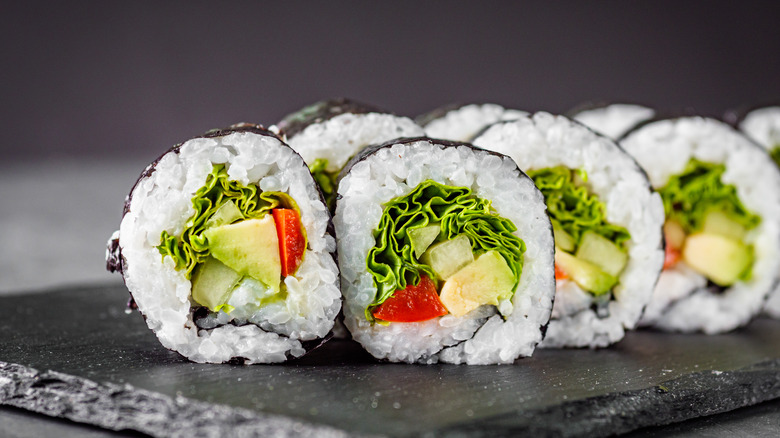What Makes Futomaki Sushi Rolls Unique?
Japanese cuisine is a deeply complex tapestry of flavorful and colorful ingredients bound together with old traditions and new innovations. It's thought that Americans' love of Japanese-style food started in the late 1960s when healthy food became trendy — and likely began with sushi, per Oryxin Flight Magazine. This filling, low-calorie dish opened the door to many other Westernized versions of Japanese cuisine.
But even just within the label of sushi, there is a lot of variation. Though it isn't the most commercialized, futomaki is fairly easy to spot in the crowd. According to Just One Cookbook, futomaki is a common and popular kind of maki – what we call sushi roll, which is different from sashimi — that is thicker and filled with more ingredients. Although there are quite a few names for these thicker rolls, depending on the region of Japan you find yourself in, futomaki literally means fat-rolled sushi (via MasterClass). This variety is typically bought or made for picnics, festivities, or bento. Their bright colors, ease of transportation, and endless possibilities of flavor combinations make futomaki uniquely versatile.
Roll roll roll your futomaki, leave in the seeds and stems
Futomaki is wonderful because you can put whatever you'd like inside of it. As long as the filling is encased in some kind of sushi rice and wrapped in nori, the ingredients are entirely up to the chef. Usually, futomaki features a lot of different and vibrantly colored vegetables like cooked spinach, pickled ginger, shiitake mushrooms, cucumbers, and kanpyo (a dried gourd), as well as some kind of protein, according to MasterClass.
While the most common types of proteins used in this sushi roll are things like omelets, dried fish, salmon, crab, unagi, and raw tuna, what makes futomaki so unique is that there is no standard or base recipe like there is with other types of sushi. A California roll will always feature crab and a dragon roll will always include eel, but a futomaki roll can be any mix of meat and veggies.
According to TasteAtlas, futomaki originated in the Kansai region of Japan as a festival food and was commonly eaten for good luck. With the standard size of a futomaki roll being 4 centimeters in diameter it's no wonder this type of sushi captured the attention of foodies across the world.

